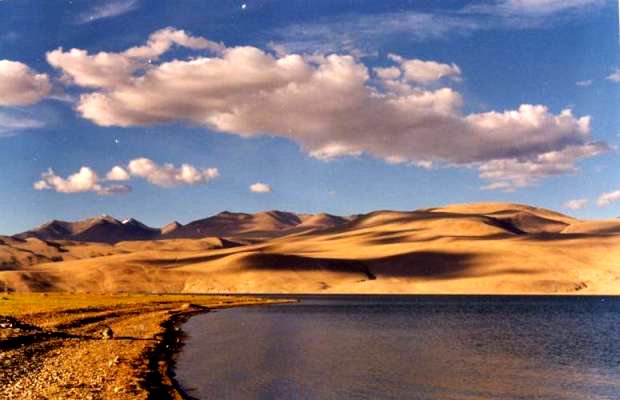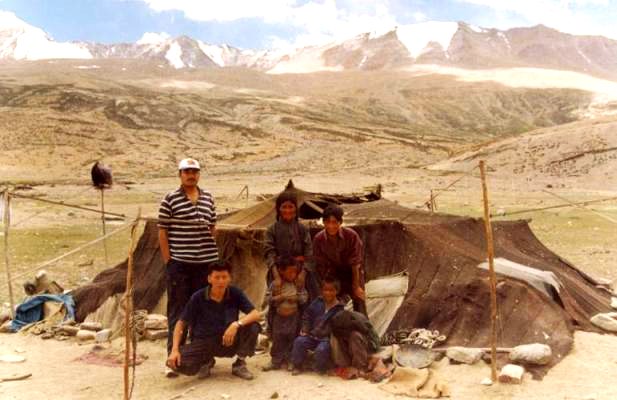The Statesman – Leisure 16th June 2004
TSO MORRIRI -- Tea with Changpas
Close to India’s highest lake, Rangan Datta meets one of Himalaya’s last nomadic tribes.
Ladakh, (literally meaning “Land of passes”) is a cold desert in the rain shadow region of Himalayas. But on its south-eastern corner is lake of Tso Morriri. At an altitude of 4450 mt it is the India’s highest lake and certainly one of the most beautiful in the world. The lake (some 20 km in length and 5 to 8 km width) is located close to the China boarder and was a restricted area till 1994. Even today tourist, including Indians, need a permit to visit this natural wonder.
Our journey to this beautiful lake started from Leh, the district head quarters of Ladakh. On a fine July morning, our Tata Sumo followed the national highway to Manali till Upshi, where we had our breakfast. After Upshi we left the Manali road and took the road along the Indus River towards the China boarder. 
The road was really beautiful and runs along the Indus as it flows through a deep gorge.
The walls of the gorge rose steeply on either side and we had an impression of traveling through a roofless tunnel. After a while the valley opened up and at Chungthang, where we had our lunch, the river flowed in wider sweeps making Chungthang seem like a green oasis surrounded by barren mountains on all sides.
The prime tourist attraction of Chungthang is the hot spring close to the river bank. Steamy jets shot out of a small opening in the rocks from where the water flowed into Indus. It was too hot to bath in, but we sat on boulders for a long time listening to the gurgle of water and admiring the beauty of Indus.
However we were soon on the road to Mahe. At Mahe there are two roads one follows the Indus towards China and the other follows a tributary of the Indus to lake Tso Morriri. This second road, which we took, was a dirt road and in a horrible condition. The swirling dust lowered visibility and made our lives really miserable. So we traveled past the village of Sumdo with our windows firmly shut. There were no more villages on this route but there were tents of Changpas, the local nomadic tribe. Just as we drove past the chorten at the top of Namshang La (4800 mts). We glimpsed a patch of blue in the distance. Our driver informed us that this was not Tso Morriri but Thadsang Karu, a smaller lake located just North of Tso Morriri. Thadsang Karu was also beautiful and we tried our best to capture it on film. Soon after we left Thadsung Karu we finally came upon our dream lake. From a blue line at the base of a mountain it grew a huge expanse of clear water on which the surrounding brown mountains were reflected. We drove along the coast stopping at frequent intervals for photographs. We stopped at last village of Korzok, where dust storm blows day and night. There are a number of camps for tourist in Korzok but, finding them a bit too expensive, we checked into the only hotel.
Korzok we found, was in the middle of a major change. There was brisk construction work everywhere, the Changpas it seems were giving up their old nomadic life style and settling down. Korzok has a Buddhist Gompa (Monastery) but it can hardly be called spectacular.
But is very close to the lake. In fact it is situated beside a small nala which flows into the lake. Crossing a marshy stretch we reached the lakeside and gazed up at the brown mountains with their small crowns of snow. We saw a number of bar headed geese floating on the water. This area is famous for water bird watching; the common birds seen in this area are bramhiny duck, black-necked crane, brown-headed gull, etc. We stayed on the shores for a long time, but after a glorious sunset we were forced to seek the warmth of our hotel room. 
Next morning found us again skirting the lake. Even a steep cliff running straight into the water couldn’t stop our happy jaunt. After lunch our driver Sonam took us to the meadows of Korzok Phu. We followed a stream upwards until we came to a meadow dotted with yaks, donkeys, goats and sheep belonging to the Changpas. There were also some Changpa tents. Sonam took us to one of these unusually shaped tents made out of yak’s wool. The Changpas call their tent rebo. On entering a rebo, we were welcomed by a Changpa lady who handed us cups of Tibetan tea (a short of tea where milk is replaced with butter and sugar with salt). At the centre of each Changpa tent burns a fire day and night and all family activities are centred round this fire. The roof of the tent has an opening allowing smoke to pass out, when it snows this opening can easily be tugging a few ropes. The Changpa family refused to accept any money for the tea, and though it was difficult communicating with them (Sonam didn’t know the Tibetan dialect of the Changpas) we felt strong bonds with them. For ages Changpas have been cattle breading nomads. Their most valuable product has been Pashmina wool, from which the legendary pashmina shawl have are made. Also valuable as a trade item has been salt, a very precious product in the Himalayan region. A few lakes in Ladakh and Tibet have salt deposit and this salt has been traditionally collected by the Changpas and traded miles away. Here everything was bartered. Salt and wool are exchanged for food grains or other basic necessities.
But the life of Changpas are changing slowly. With a steady supply of salt coming from the city many Changpas have had to turn to agriculture and other trades. They have also learnt the real value of pashmina wool and are forming co-operatives to ensure that they get the right price for the wool. Next morning we bid farewell to Tso Morriri. But as we took a detour to Leh, through uninhabited territory past the lake of Tso Kar we were once more reminded of the Changpas. Beside the hot springs of Puga, where boiling water was rising like a fountain from the ground we saw natural salt deposit. Mile after mile, covered with the white powder of sodium chloride. Again at Tso Kar, the lake water which appeared black not blue, was surrounded by a white salt deposition on all side. For thousands of year this salt have been a lifeline for Changpas now, as it should be, they are growing out of dependence and marching ahead. |

